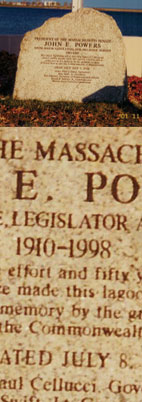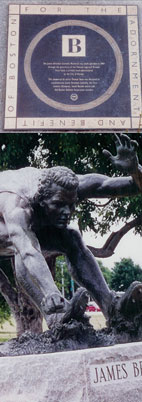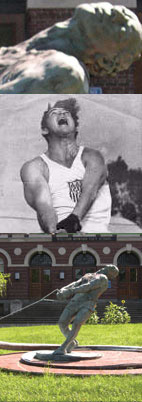NEIGHBORHOODS

- USS Constitution
- Winthrop Square
- Bunker Hill Monument and Museum
- Bunker Hill Catholic Cemetery
- Deer Island Irish Graveyard
- General Edward L. Logan
- John J. Moakley Federal Courthouse
- Castle Island
- Dorchester Heights Memorial
- John E. Powers
- St. Augustine's Cemetary
- James Brendan Connolly
- JFK Presidential Library & Museum
- John McCormack Marker
- Annie Glover Plaque
- Holy Cross Cathedral
- Hibernian Hall
- Forest Hills Cemetery
- James Michael Curley Mansion
- Harold Connolly Statue




CHARLESTOWN
USS Constitution
Charlestown Navy Yard
America's greatest ship was commanded in the War of 1812 by Commodore Charles Stewart, who was the grandfather of Ireland's famous Home Rule leader, Charles Stuart Parnell, and poet Fanny Parnell. Of the many Irish sailors served on the Constitution, Daniel Hogan was perhaps the most famous. During a heated battle with the British frigate Guerriere, the American flag was shot from the masthead. Hogan climbed the rigging and amid gunfire he tied the flag back in place, so the battle could continue. The US Navy named a ship, the USS Hogan, in his honor.





CHARLESTOWN
Winthrop Square
Winthrop Street
This historic park contains the Bunker Hill Tablets, which cites the names of Irish-born soldiers who fought against the British at the Battle of Bunker Hill in 1775. Among the names are Colonel John Stark and Major Andrew McClary.
Also in the Square is the Charlestown Civil War Memorial by Sligo-born Martin Milmore, dedicated in 1872.
Across the street from Winthrop Square is the former home of John Boyle O'Reilly, who lived at 34 Winthrop Street. His funeral mass in 1890 was held at St. Mary's Church at the corner of Winthrop and Warren Streets.




CHARLESTOWN
Bunker Hill Monument and Museum
42 Monument Square
The 221 foot granite obelisk marks the battle between British forces and colonial militia on June 17, 1775. Historian Michael O'Brian's book, the Irish at Bunker Hill, identifies 176 Irish-born colonists and hundreds of Irish-American soldiers who defended the hill during the siege. The Marquis de Lafayette helped lay the monument's cornerstone in 1825, and the monument was officially unveiled in 1843.
Across the street from the Monument is the new Bunker Hill Museum, run by the National Park Service. The museum includes an exhibit on Charlestown's illustrious Irish traditions.




CHARLESTOWN
Bunker Hill Catholic Cemetery
St. Francis de Sales Church
303 Bunker Hill Ave.
This Catholic burying ground opened in the 1830s, at the height of anti-Irish sentiment in Charlestown. In 1832, despite the objections of town selectmen, Bishop Fenwick buried two Irish children, three year old Florence Driscoll and three month old James Kinsley, in the graveyard, setting the stage for a court battle that successful argued that Catholics could be buried on private property. The cemetery is closed to the public but visitors may contact the Catholic Cemeteries Association for permission to enter.




DEER ISLAND
Deer Island Irish Graveyard
Boston Harbor
The Rest Haven Cemetery at Deer Island contains the graves of several hundred Irish immigrants who died at the quarantine station after fleeing the Irish Famine in the late 1840s and trying to reach America. Irish ships had to stop here and each passenger was examined by the port physician before coming ashore. Most quarantined Irish suffered from typhus fever or cholera as well as physical ailments induced by hunger and trauma.
Today the island is a wastewater treatment plan run by the Massachusetts Water Resources Authority. On May 25, 2019, a permanent memorial was unveiled on Deer Island overlooking the Boston skyline.




EAST BOSTON
General Edward L. Logan
Boston Logan International Airport
Boston's airport is named in honor of Edward L. Logan, a first generation Irish American from South Boston whose family came from Ballygar, County Galway. Logan enlisted in the 9th Irish regiment, where his father Lawrence was Lieutenant Colonel, during the Spanish American War, and he commanded the 101st Infantry regiment during World War I. He served South Boston as representative and senator and was later appointed municipal judge. In 1943, when the state legislature approved a $4.75 million expansion, the airport was officially named in honor of Logan.




SOUTH BOSTON
John J. Moakley Federal Courthouse
Northern Avenue
US Congressman Joe Moakley from South Boston had an illustrious career in politics that lasted nearly 50 years. During that time he championed jobs and healthcare for the people of his working class district, helped create immigration reform on Capital Hill, and brought attention to the Salvadoran death squads killing priests and peasants. "The Moakleys are from County Cork. My paternal grandmother was a Connolly from Galway," he told a local newspaper. The Moakley Courthouse on Fan Pier overlooks Boston Harbor, and offers a variety of public and education tours.




SOUTH BOSTON
Castle Island
William J. Day Boulevard
Castle Island's history dates to 1634, when settlers built a fort with mud walls. The British called it Fort William during the Siege of Boston in the 1770s, but once they left we called it Fort Independence.
Castle Island was connected to the mainland in the 1930s, and it is often called the Irish Riviera. In recent years an Irish Ceili is held each summer on a Sunday, attracting hundreds of dancers and musicians. A great place to walk, talk and watch the planes flying in and out of Logan, Fort Independence is a National Historic Landmark.




SOUTH BOSTON
Dorchester Heights Memorial
Thomas Park, G Street
On March 17, 1776 Dorchester Heights was where American colonists aimed their cannons at the unsuspecting British Fleet, forcing British troops to evacuate Boston. It was a turning point in the Revolutionary War.
Henry Knox, from a family of Scots-Irish Presbyterians, dragged the cannons from Fort Ticonderoga, New York to reach Boston in time. General John Sullivan was the commanding officer. The password that day was Boston, the countersign St. Patrick, in honor of the Irish feast day.
The Memorial was dedicated in 1902 and is managed by the National Park Service.




SOUTH BOSTON
John E. Powers
William J. Day Boulevard
As president of Massachusetts State Senate in the 1950s, John E. Powers, who was once described as "South Boston personified?" First elected as state representative (1939-46), and then state senate (1947-64), Powers was the first Democrat to be elected senate president (1959-64). Powers helped to create Pleasure Bay, a 170 acre lagoon encircled by a pedestrian walkway that runs alongside South Boston's coastline overlooking Dorchester Bay, leading right to Castle Island.
Stephen F. Lynch and John A. Hart, Jr., led the process to place a plaque at Pleasure Bay acknowledging Powers' great service to Boston.




SOUTH BOSTON
St. Augustine's Cemetery
225 Dorchester Street
As Irish and French settled in Boston after the Revolutionary War, Boston's selectmen were finally forced to allow a Catholic cemetery in Boston. In 1818 permission was granted, and St. Augustine's cemetery became the first Catholic burying ground in New England. A chapel was built in 1819 for Mass, and in 1868, St. Augustine's officially became a parish under the leadership of Reverend Denis O'Callaghan.
Today the chapel and cemetery are beautifully cared for by local residents and is a tribute to the early Irish settlers.




SOUTH BOSTON
James Brendan Connolly
Joe Moakley Park
Old Colony Road
The son of Irish emigrants from the Aran Islands, South Boston's Connolly was the winner in the Modern Olympics in Athens, 1896, capturing first place in the triple jump and second place in the high jump, and third place in the long jump. He returned to the Paris Olympics in 1900 and took second in the triple jump. Connolly was also an accomplished writer, publishing 25 novels and short story collections, and a journalist, covering the Spanish American War, World War I and the Irish war of independence.




DORCHESTER
John F. Kennedy Presidential Library & Museum
Columbia Point, Dorchester
The John F. Kennedy Presidential Library and Museum is dedicated to the memory of our nation's thirty-fifth president. A descendant of Irish famine immigrant families -- the Kennedys and the Fitzgeralds -- who fled to Boston in the 1840s, John Fitzgerald Kennedy was the first Irish Catholic president of the United States. He represented for Irish-Americans a vindication of their long and difficult struggle to gain acceptance and success in Boston. Located on a ten acre park overlooking Dorchester Bay, the JFK is one of twelve presidential libraries administered by the National Archives and Records Administration.




DORCHESTER
John McCormack Marker
Columbia Road
One of 12 children born to Joseph and Mary Ellen (O'Brien) McCormack, John W. McCormack was raised near South Boston's Andrew Square. In 1928 he became a US Congressman, where he earned the nickname "The Fighting Irishman from Boston" for his feisty, tenacious personality. In 1958 he sponsored the bill to create the National Aeronautics and Space Administration (NASA), which helped put the first man on the moon. McCormack was Speaker of the House from 1962-1970. The John W. McCormack Institute at UMASS/Boston is named in his honor.




NORTH END
Annie Glover Plaque
St. Stephen Catholic Church
401 Hanover Street
The last woman to be hanged as a witch in Boston, in 1688, was Irish immigrant Annie Glover, wildly accused by the infamous Reverend Cotton Mather. Enslaved by the British, she and her family were sent to Barbados in the 1650s. In 1680 she made it to Boston with her daughter, and worked as a washerwoman until she was accused of witchcraft. During the trial, she only spoke in Irish, and Mather called her "a scandalous old Irish woman, obstinate in idolatry."
On November 16, 1988, Boston City Council proclaimed Ann Glover Day in the city of Boston




SOUTH END
Holy Cross Cathedral
1400 Washington Street
Boston's Catholic cathedral was built by architect Patrick Charles Keely (1816-1896). The son of a church builder, Keely was born in Thurles, County Tipperary, and moved to the US in 1842. He was inspired by 13th century Gothic design, and during his career built over 600 churches and 16 cathedrals.
The Cathedral moved from Franklin Street to the Sound End in 1866, when ground was broken, and took a decade to complete. It sits on an acre and seats 3,500 people. A beautiful stained glass of St. Patrick graces the cathedral.




ROXBURY
Hibernian Hall
184 Dudley Street
The headquarters for Boston's Irish community for five decades, Hibernian Hall was designed by Edward T.P. Graham and officially opened by politician James M. Curley on May 30, 1913. It flourished for half a century as generations of Irish immigrated to Boston, but then fell into disrepair and was abandoned in the early 1960s.
It was nearly demolished in 1997, but was designated an historical property by the Massachusetts Historical Commission. In 2005 the hall was restored by Roxbury Consortium of Arts, Culture and Trade (ACT) is proudly called Roxbury Center for Arts at Hibernian Hall.




JAMAICA PLAIN
Forest Hills Cemetery
95 Forest Hill Ave
This beautiful cemetery has several Irish items of note, including the tombstone of Eugene O'Neill (1898-1953) , Nobel Prize winning playwright, whose plays explored an Irish-American psyche. The Milmore brothers of County Sligo, Martin, Joseph, James and Charles, famous for their Civil War memorials, are buried here beneath an powerful memorial by their friend Daniel French entitled Death Takes the Sculptor. It is right inside the front entrance. Martin Milmore's Roxbury Civil War Soldier, is also here. The Jamaica Plain Historical Society offers fascinating tours.




JAMAICA PLAIN
James Michael Curley Mansion
350 Jamaica Way
Mayor Curley had this Georgian Revival, 21 room mansion built in 1915, complete with a crystal chandelier, Italian marble fireplace, mahogany interior and a three-story spiral staircase. The ornate shamrocks carved into the 30 window shutters came to symbolize the triumph of the Boston Irish in the political arena. The contractor was Thomas O'Connor, whose firm also built a number of schools throughout Boston. The City of Boston owns the mansion, which overlooks Jamaica Pond, and uses it for community events and youth leadership conferences. The Boston Trust Office maintains the grounds.




BRIGHTON
Harold Connolly Statue
20 Warren Street
Olympic champion Harold Connolly is a truly historic figure in Boston annals. His left arm was damaged at birth and he spent his youth in physical therapy. He worked tirelessly on strength conditioning and emerged as a champion in the hammer throw, setting the American record twelve times, and the world record seven times. In 1956, Connolly won the gold medal in Melbourne, Australia.
Artist Pablo Eduardo's sculpture of Connolly was dedicated in December 2005 by state representative Kevin Honan and attended by Connolly and his family and friends. Connolly continues to coach young athletes.




